Navico Broadband Radar, beta demo
It’s a lousy photo (even clicked larger), but amazing once you understand it. Notice the piling somewhat hidden behind Navico Broadband Radar engineer Don Korte and right off the bow of yesterday’s demo boat. Then check out the screen of the Lowrance HDS 10 slightly obscured by my new colleague Chris Woodward (who writes for Sport Fishing). It’s delivering a clean target plot of the piling less than 30′ from the 18″ scanner dome! I saw this sort of extraordinary near-range performance all over Biscayne Bay yesterday. The little scanner easily resolved a quarter mile string of channel pilings like this one, and all the boats using the channel, and it separated a 40′ sailboat close to a low shore over a half mile away. And that was all in complete auto mode; with a little tweaking we could sometimes see crab pot buoys like the one lower left in the photo, or gulls sitting on calm water.
Chart radar overlay isn’t implemented in the HDS series yet, but purportedly will be when Broadband Radar actually “ships in Q2.” The overlay is working in Simrad NX series, as seen below, but the planned Marpa feature isn’t yet (the less expensive Lowrance BR will not have Marpa). In other words, what we saw yesterday was beta BR. Also missing was Interference Rejection, the ability to ignore the pulses of regular magnetron radars, and we did see some noise spokes when near some running yacht and ship scanners. While a technical paper at Navigate-us.com suggests this is a real issue for FMCW solid state radar, Don Korte says the Navico team is very close to delivering excellent IR.
Unfortunately it was quite rough for small boats outside the Port of Miami yesterday and so we didn’t get to see how Broadband Radar handled real sea clutter or how well it targeted ships and boats at distance. The 6, 8, and 12 mile ranges seemed OK, but I’d like more time with them. That said, near range high performance is indisputable. The clean, informative target overlay below is at about 1 mile range, and it stays good all the way down to 1/16th mile range (aka 400′) and even never-seen-before 300′ and 200′ ranges. When we drove up tight canals we could easily see details beside the boat and well ahead of us, and even individual moored boats around the corner. I have no doubt that BR would be a very useful tool for, say, working my way into Camden Inner Harbor (see the header photo) in the thickest of fog or darkest of night.


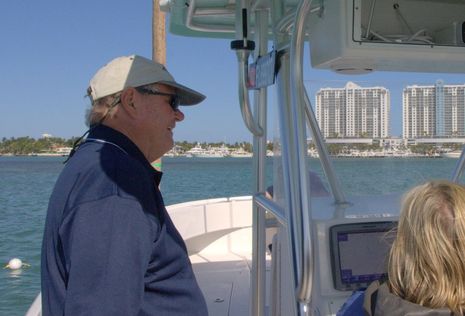
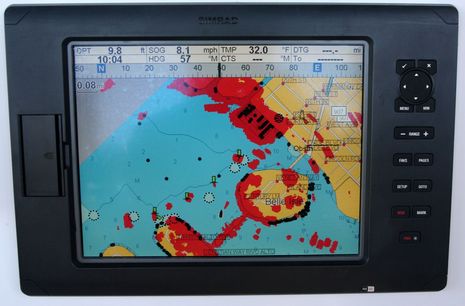
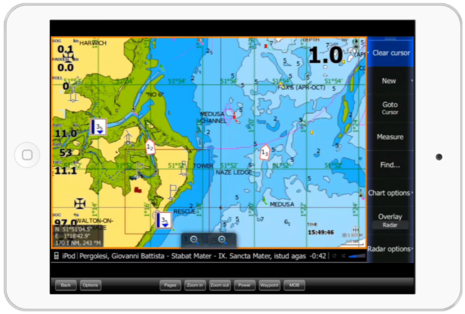
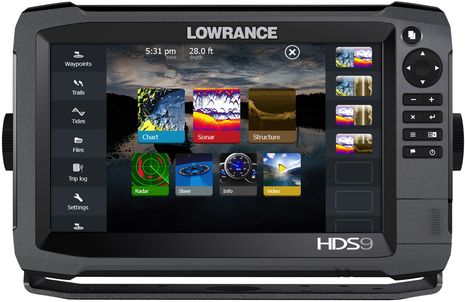
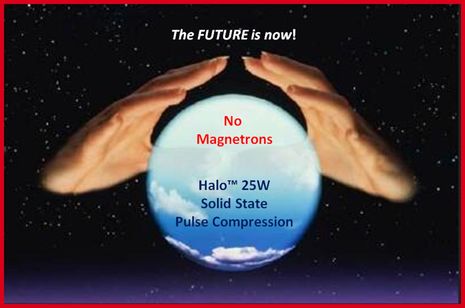
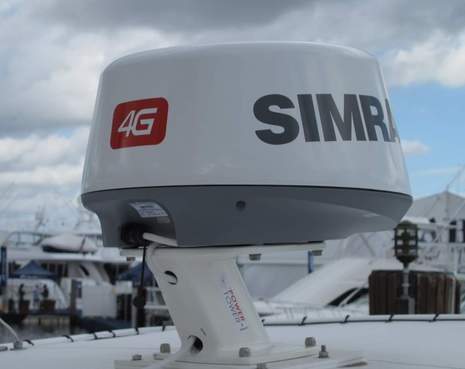







Ben, our technical update (comparing FMCW-broadband and Pulsed radar technology), on http://www.navigate-us.com, does outline some of the potential problems FMCW may experience, including Interference rejection.
It also outlines the upside, such as improvements in the short range performance (as your report outlines)and the potential to post process the returns more effectively. FMCW has the potential to be a real step forward in helping user make more of their radar. We can all look forward to a more comprehensive test to come.
Can the broadband radar pick up racon signals ?
No, Racon beacons will not be activated by FMCW radar, but real testing in future will tell.
How about performance in adverse weather? And, is there a truly significant power savings over a traditional radar?
Anon
Don Korte told us that Broadband Radar uses about 30% less power than a 2kW magnetron scanner, and 50% less than a 4kW. But I don’t think those figures include the power savings possible due to Broadband’s nearly instant turn on and a standby mode that uses only 1.6 watts (versus 18 watts typical of a normal 2kW, according to Korte).
Korte also told us that BR will not trigger a RACON bouy. But I’d add that many of those buoys may become AIS equipped eventually.
I didn’t see how well this radar can detect storm cells, but Navico says it can see rain fine and I understand that the 24 mile range is specifically tuned for it. While there’s a fair amount of manual control available to the BR user, I gather that the engineers have a lot more control over subtleties like how the 16 color target pallet is used.
Is is significantly lighter than current models? So much so for instance you could move it to the main mast instead of the mizzen mast on a ketch?
Its only a couple of lbs lighter than other radomes and in some cases its the same.
No big surprise really: Navico Broadband Radar won the NMMA Innovation Award for electronics today.
Also a detail I meant to mention: the FCC rates its “safe distance” as zero feet, or, as Don Korte says, “it’s a radar you can love,” i.e. hug.
Is this technology making it’s way into Raymarine products ?
Power consumption is not an issue for power boats.
it does become an issue for sailboats not under engine power. I have found that when conditions or poor visibility are present I use the motor more often than not, even motor sailing.
Sailing at night in good visibility is a power consumption challenge for sailing yachts so then it would be a consideration. In that case you can go to lower power standby and power up when you need to have a look see.
I don’t see the utility of seeing things 30 feet away which weren’t 200 feet away at some earlier moment and 500 feet earlier still. Once you pick up such a target you can track it’s CPA and hopefully get your eyes on deck and make a visual. If the visibility is too poof for that you should get the hell out of the way.
No?
SanderO
….and since the big displays are the main source of power consumption, I think the most important question for me will be:
– Is the Navico Broadband Radar better than the 4 KW Furuno DRS4D Radar ?
Ben,
Today I received interesting news from Jeppesen:
Broadband Radar Technology Delivers Improved Short-Range Target Resolution, Enhanced Radar Overlay for Systems Compatible with Jeppesen Marine C-Map Charts and they are lowering the price of their existing Koden sourced radar box from $3000 to $1999.
Now that announcement could be just about non-Jepessen systems compatible with C-Map, but what about Nobeltec? Can you check up with them and see whether Broadband radar is going to be in Nobeltec’s future?
That would totally vindicate my plan to equip my new boat with Nobeltec and a Lowrance HDS-8 with BB radar.
I just saw the dome and system at the Miami Boat show. For me, it is too ugly and an unproven.
Their strange marketing argument that it is safer than traditional marine radar is a little crazy to me as well. For example, their marketing says that the power level is safe because it is “less than a cell phone”. Does this mean that a cell phone is not safe with most people walk around with them pressed to their heads all day?? While this is a slightly rhetorical question and no one is going to use the antenna as an ottoman, although the dome appears to be taller than the one in my living room, the argument is meant to generate fear and is marketing hogwash!
Indeed, I want my radar to have enough power to work when I need it to see through the crap that the atmosphere can generate and I don’t need to see a target less than 25 feet away when I should be getting out a fender or taking cover instead of watching the collision occur on the display!
Anyway, this is just my initial observation and I would like to see some non-biased real world performance test comparisons.
Jay
Deep breaths everybody. I hear a bit of “If I don’t have it you don’t need it” going on. Lets not condemn an innovation based on fragmented or biased information. Time will tell how valuable this concept is.
I for one am very interested in close in detection as well as saving power.
Hi Guys, I hope you don’t mind me mentioning, as Ben alluded to it in his introduction, the report on http://www.navigate-us.com outlines the pro and cons and the future hopes of the broadband technology. I believe Navico should be credited with being first with FMCW, now its question of how well its been implemented.
Greetings,
Having a close quarters scale can be a very very good thing. In 2000, I had been going north on the ICW through North Carolina, with my Morgan 41. We pulled into a marina one evening in total darkness and had to play “dodge the pyling.” Having radar sweeps of that field would have been helpful. Of course, Low-lux, and FLIR, would have been good, too. Regarding radiation, Radar on MOST sailboats/powerboats is pretty safe, and unless you are pressed up against the dome/emitter for a goodly amount of time, you are not going to be frying anything. A ship’s emitter (commercial/naval grade), on the other hand, will boil water. The difference is, primarily, expectations. Using the formula of visibility in nm = 1.144 times the height of the emitter in feet, radar can see that even with 50 feet of height above sea level, you “see” only 8nm to the horizon (and add to that the corresponding height of the target with the same formula). On a ship, with a mast height of 120+ feet, radar can see further, but still not greatly beyond. I have been on watch with the 96nm scale running and have picked up radio masts at the fringe of that, as I recall the Isle of Wight. But it is few and far between that you pick up much beyond 24nm range, and on a sailboat, 12nm is pretty damn good.
+1 What Sandy wrote at 12:04pm about not condemning an innovation based on fragmented or biased information.
What I will be looking for in a replacement radar / complimentary chartplotter package (I have no interest in stand alone radar) is:
– A visual display that my crew can successfully & confidently use in collision avoidance in coastal waters with less experience and training then what is required in today’s units. I have no technological bias as to how this is achieved.
– For myself in harbors: The ability to confidently avoid collisions while transiting thru narrow channels / harbors / mooring fields / anchorages full of mostly stationary targets. E.g. the shape of stationary targets don’t change as I move thru a close collection of boats, and that boats moving in the mooring field are clear vs. those that are stationary.
– For myself in coastal waters: Not so interested in range. Very interested in having a more noise free display in bad weather and choppy water. E.g. By more noise free .. ideally there is still a little bit of noise, so I know that the automatic filter is close to the edge and not overly filtering out targets with poor returns.
– No need to adjust settings as I switch back and forth between ranges, and an indication
(especially for my crew!) that their choice of settings have filtered out small boats
– MARPA provides me a targets true heading and speed, and a one button toggle between true and relative heading & speed for both the displayed values and the heading lines drawn on the targets.
– MARPA windows (e.g. list of targets) are inclusive of AIS targets
– AUDIO ALARMS (MARPA & otherwise) : Much better handling of alarms, and different behavior for ocean / coastal / harbor / transiting channel. Options for no or limited audio tones. Use different tones for different alarms, and less urgent sounding tones for information only alarms. For example, all targets go out of range eventually, stop blaring out ear defining alarms each time please. For example, all targets are going to appear to be in a collision course when transiting a channel or harbor entrance .. how about no alarms .. or be smart, just give me an audio alarm if someone is over taking me from astern ? If ARPA, how about a tone to alert me a new boat has appeared on the display nearby my position. How about an easy option to temporarily kill alarms. On sunny days when I am using the radar, just to keep my skills up, I hate alarms breaking up the calm conversation among my crew, or waking them, or giving the impression I am bored with conversation and am instead entertaining myself. (few crew appreciate the need to get experience with radar on clear days)
– VISUAL ALARMS (MARPA & otherwise): It’s an issue for me today that I setup MARPA targets and leave the helm to my crew, who get confused and panicked when a big alarm message box appears dead center in the screen blocking the view of what they are looking at. Rather than showing a big box that says “target 3 is lost”, place a small alarm message along the bottom to supplement the blinking target 3 circle already provided. If I can tell from the tone of the alarm that its just an information alarm, I will also know from wherever I am sitting I don’t need to take a look.
– Bonus: have the ability to display two radar images at different ranges.
– Bonus: power savings mode. Based on heading sensor input, if my boat is staying on a constant heading, have the radar transmit less frequently, reducing energy output by 75% (e.g. in the time it would make 4 pulses, do only 1 and skip 3) The ability to realize there are no targets nearby and do this automatically would be nice also.
– Bonus: Detect that a target is stationary (e.g. fixed lat/long), and make it more of pin prick in size, and change it’s color or shading.
– Bonus: Detect that a target is the same as an AIS target, and clean it up so that it doesn’t paint as wide on the display as it would otherwise be due to limits in the angular resolution of my 18” radar.
– Bonus: Always be calculating the heading/direction of every object returning radar, so I can just hover a cursor over a target and see .. two arrows, for each of true and relative heading of a length proportional to speed, and a window showing true and relative headings in magnetic north and speed in knots.
Actually … in regards to alarms, it would be ideal if alarm handling can optionally be handed over to a multipurpose instrument display, so no alarms pop up on a chartplotter freezing the display until an acknowledge button is pressed.
Sorry, Kees, Broadband Radar is not going to become compatible with Nobeltec. I asked Navico if there was any possibility that they would make the scanner available to other companies, particularly charting software developers, and— while they didn’t say flat no—they didn’t sound enthused. I understand their point of view, but it would be neat to see what Nobeltec, Rosepoint, and others would do with BR.
Jeppessen confirmed this and said the release was only meant to point out that BR works on several MFDs that use their C-Map cartography. In fact, overlaying the high near range resolution of BR does challenge chart accuracy.
Kieran:
You are promoting your own web site. That smacks of commercial interest. Don’t you think some moderation would be appropriate?
Dan, a radar manufacturer would have to pay $25,000 at least for a focus group to come up with the summary you so elegantly put into a half foot of column space. Kudos. I hope someone was listening.
I’ve done some checking and calling…
I’m looking at the Furuno DRS2 Radar and Navnet 3D and comparing it to the Broadband radar and I fail to see any major advantage.
According to Furuno and the specs, the minimum safe distance to the DRS2D ia also zero. Additionally, Furuno said that if I slow down the antenna speed from the normal 48 rpm to 24 rpm, the system will drop about 10 watts in power which makes the power consumption almost the same.
Furthermore, if you look at how big the broadband dome is compared to the Furuno DRS2D dome, the increased windage will more than offset any remaining power advantage. A rough guess is that the surface area of the dome is about 2 times bigger. And, from sailing knowledge,that increased windage will increase exponentially with the square of the boat or wind speed!!!
Other than slightly better close range detection. (about 30 feet better according to Furuno)and probably much worse long range detection….
What is the tangible advantage?
At this time, I only see a disadvantage if you consider that the broadband will not trigger Navigation Racons or detect longer range targets as well on my boat.
I got most of my information from the Furuno www site and by calling Furuno if you want to confirm anything I have said
Jay
Very interesting, Jay, but I checked out the DRS2D installation manual and couldn’t find a safe distance of 0′. I did find a complicated radiation hazard warning that I don’t understand.
What you may be missing about Broadband Radar is its range resolution, claimed to be 2-3 meters. I’m dubious that any other 18″ scanner can match its detail inside a mile or so, and high range resolution should also mean exceptional sea clutter control. But I have not seen a Furuno DRS2D in action, and I know their UHD technology is very good. I’d like to test the major small domes side by side, and hope to pull it off this summer.
I have been responsible for computing the safe distance for Commercial Weather Radars – including Solid State Systems of 150 Watts Peak down to 40W peak. The Critical issues are Antenna size and AVERAGE radiated power.
It is the AVERAGE power that determines the likelihood that damage will occur in human tissue. So if you look at a 4KW typical magnetron system the average power is about 4Watts, while the average power of the FM/CW radar discussed here is 0.1Watt. So its clear that there is a 40:1 safety advantage over a typical radome radar and when addressing 10, 12 – 25 Kw versions capable of up to 25Watts average its clear the safety factor increases to over 240:1 in favor of FM/CW. WRT a cell phone – they mean that if a cell is safe then our radar is more safe.
It is very important to note that if a safe distance is 10 – 12 feet – that is NOT ZERO. I have seen many dangerous installations of radome systems on powerboats where the flybridge steering position is directly exposed to a distance far less than 10ft. Don’t forget that your GPS antenna / receiver maker specifically says to NOT locate the GPS directly in line with your Radar. In that case you are striking delicate receiver components with exceptionally high voltage levels that will eventually destroy the GPS receiver.
One thing that is ignored is that Magnetron systems decay in performance over usage time. They constantly loose transmitter power and pulse shape can become distorted over the years of operation. That results in steadily decreasing resolution and loss in sensitivity. That is most critical to commercial operators who use their systems daily, but at some point your system performance will decay. Tuning will not help. Solid State systems see no decay in performance and can be optimized continually. Eliminating a high voltage power supply also adds reliability.
Its also important to look at average transmitter power when trying to compare DC power consumption overall by FM/CW or Pulsed systems – the difference in average transmitter power is an indication of the potential savings in DC power consumption – so its not going to be astronomical savings.
The size of the FM/CW radome is TALLER than typical systems because there are separate transmit and receive antennas stacked one over the other. While this is a problem for this particular version of an FM/CW radar – if the radar is implemented correctly – there is no need for two antennas. I have built many single antenna FM/CW radar systems – but they take care and attention to specifics. So do not decide that this technology is fundamentally flawed. In fact if you were to combine FM/Cw mode with Pulse Compression recently demonstrated with a single antenna – the results will be exceptional.
Solid State will eventually dominate radar. These may be early days the marine world but the trend is coming. Solid State radars have been standard in the aviation industry now for at least 20 years, so Marine radar is behind the times – ONLY BECAUSE OF COST. That is now changing and Solid State will eventually take its rightful place.
FM/CW is the step towards very low cost that will challenge all 4KW radome systems where the extra windage of this particular system (using two vs one antenna) is not considered a major deal. Eventually a single antenna system will emerge and this last issue will be overcome. I also believe that there are issues related to the implementation of the modulation system of this radar that limit its range. Eventually that will be corrected as well and this will no longer be viewed as a 30ft radar.
Thanks, Dave.
I wish I hadn’t started this entry with how close BR can plot a target. It really is more than a 30ft radar!
Readers, more on Dave’s own solid state radar here:
https://panbo.com/archives/2008/11/honeywell_pc_ss_radar_wow_again.html
Larry Brandt wrote “Dan, a radar manufacturer would have to pay $25,000 at least for a focus group to come up with the summary you so elegantly put into a half foot of column space. Kudos. I hope someone was listening.”
.. Thanks Larry !
Radiation safety is a particular concern of mine.
I am of the belief that there are two types of risk posed by high power RF. One is the AVERAGE POWER tissue damage concern well described by Dave V above. The other, I believe overlooked, concern is the potential for DNA damage due to PEAK POWER. I am not a physicist or chemist; but I envision that it is the peak power that could split off electrons from an atom, thus causing DNA damage that could perhaps lead to long term health issues. I see two serious threats from this scenario: 1. the potential damage to a fetus that could lead to birth defects; and 2. the potential for leukemia and other such diseases later in life.
My evidence supporting this concern is admittedly anecdotal. Back in the day when I was a USAF radar tech, my then-wife, pregnant, visited our radar site on an Armed Forces Day tour, during which she went on the antenna deck of a (transmitter deactivated) heightfinder, but only a couple hundred feet from an active 10 Megawatt search radar. The baby died at birth due to a malformed heart. What conclusion would you make of this? For over 40 years I have questioned this “coincidence”.
Walk through any marina and you can see numerous instances of hazardous radar antenna location. I am convinced that installers regularly fail to adequately consider radiation safety in their placement of antennas. As stated above, for even a 2kw transmitter, there is no safe zone that is Zero feet.
I have to say on looking at the initial results this is exactly what I require what units will it work with, I have just bought a new rib and was not going to fit a Scanner due to worries over radiation, this eliminates them worries I am no electrical engineer but find your comments bizarre Jay, this allows me to go out in any conditions in harbour with the kids, I for one dont want my kids anywhere near a magnetron driven radiation device. As long as I get 15 miles which they assured me I would during a visit to LIBS recently this absolutelty ticks all the boxes, anyone know when it is available?
BlueMendes,
The Broadband Domes are compatible with Simrad’s NX series, Northstar’s 8000i and M Series, as well as all the Lowrance HDS units. According to Navico, they’re realistically projecting Mid-April for the domes to hit the shelves.
Tim Bartlett has a prototype BR, and he’s impressed:
http://www.timbartlett.co.uk/product.html#Navico_broadband_radar_sea_trials
An interesting article by Bill Johnson on Broadband radar here –
http://www.wileynautical.com/view/0/120d75abbc0.html
Will it turn out that the claimed BR limitations on long range target discrimination will be one of Ben’s “memes” — i.e. something many folks think they know even if there’s no evidence that it’s true?
With reference to Tim Bartlett’s article (tanker at 13 miles) that’s good enough for me. Theoretically the combined height of radar antenna and target to show a target at 13 miles is 35m (115 feet).
Thanks, Roger, very interesting. It’s going to take a while but I will definitely be testing Broadband Radar on my new boat, and it should be fairly easy (I hope) to do direct comparisons with other modern radomes.
Agreed. Even something a bit less than 13 miles is an easy trade off to accept in return for seeing targets that are in close.
My question is not how well you can see things close up that a flashlight would find (lots of comments on that). It is about seeing through rain and fog. How does the broadband radar compare to other radars you would find on a 40′ boat. At 2-5 miles will I see the freighter coming towards me? Will I be able to see that it is a large vessel and not a small pleasure craft? At 10 – 15 mile can I see if that rain cell is raining? I have looked but these type of questions have not been posted.
Greg, The BR24 seems good at seeing through rain and fairly good at indicating target size at medium ranges. I’m not sure about seeing a rain cell at 10-15 miles as I haven’t gotten to try that.
You might appreciate reading backwards through my testing series:
https://panbo.com/archives/2009/10/18_radomes_6_marpa_true_wakes_edition.html
There’s also a new Navico “Essential Broadband Guide” that’s pretty good:
http://www.simrad-yachting.com/Products/Marine-Radars/Broadband-Radar/
Hello all,
What have folks found with the Navico BR24? My Raymarine magnatron has died so I am looking for a replacement system. Ideally I am looking for a system that will interface to Rosepoint and AIS.
Henry, Not sure that you saw that I did quite a bit of testing with the BR24 and other radomes in 2009. You can find all the entries starting here and linking back:
http://goo.gl/3lMBU
I don’t think I’ve written an entry about the improvements Navico added via software update in 2010, but they’re nice. Navico also made it possible for other developers to work with the BR24 last Spring:
http://goo.gl/B6Rn8
But as far as I can tell, few or none have used the BR24 SDK, probably because the license fee is high. However, there are rumors that that situation will change, and the rumors include Rose Point. Nothing definite yet, for sure, but I for one am crossing my fingers.